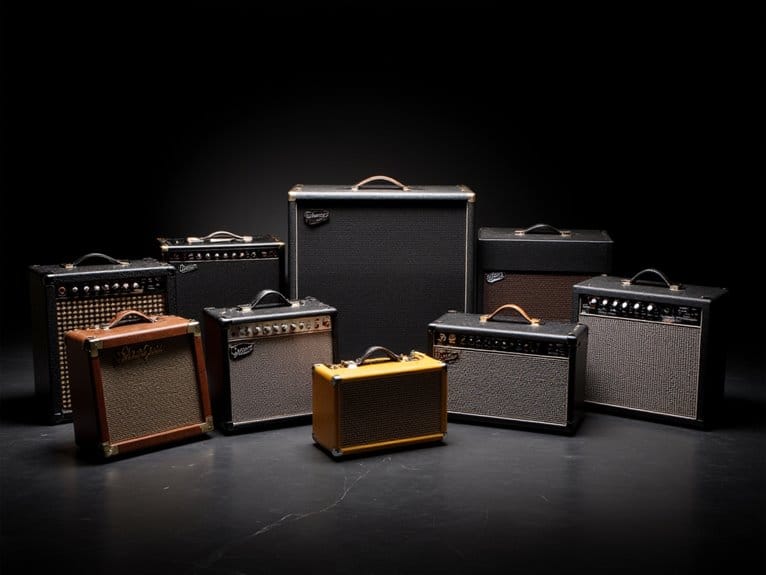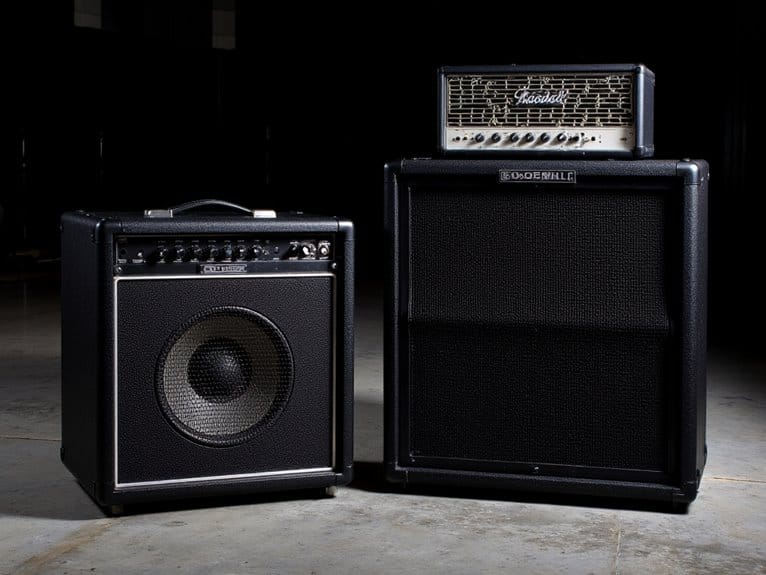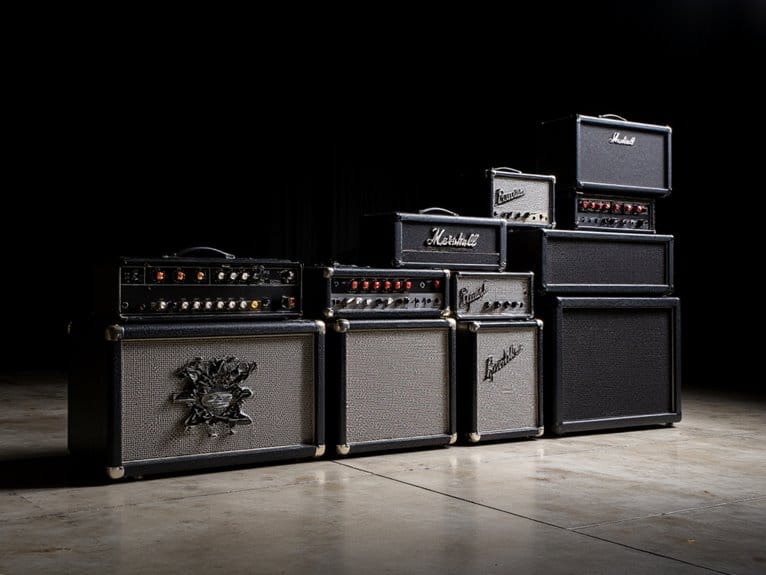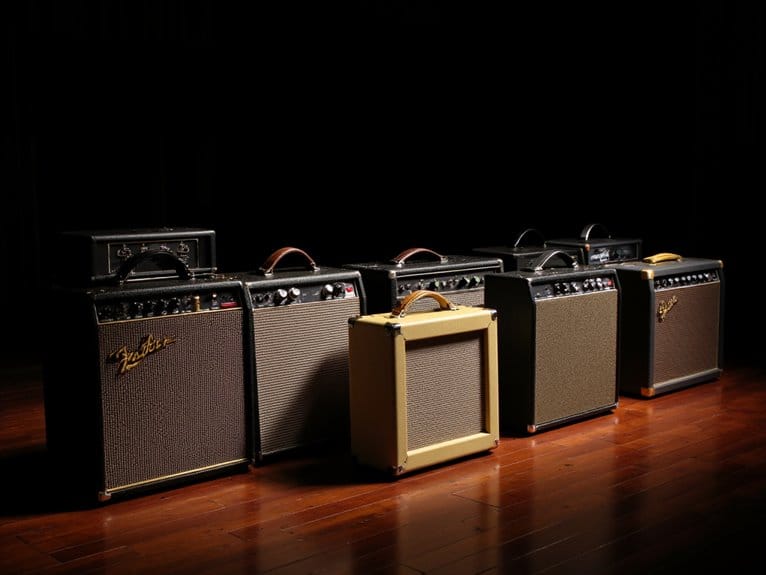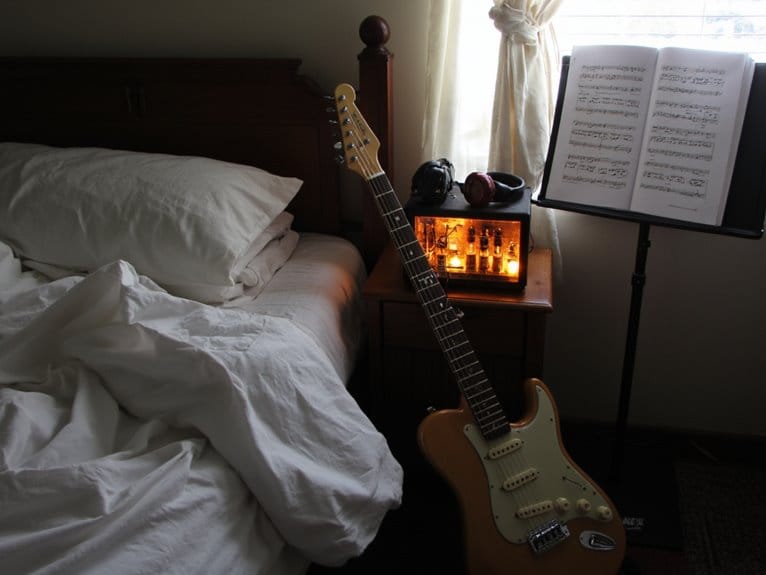Best Lightweight Guitar Amps for Gigging Musicians
I’ve found the best lightweight guitar amps for 2025 gigging include the Fender Mustang LT25 (25W) offering authentic amp modeling with USB connectivity, and Rockville G-AMP (20W) providing dual inputs for collaboration.. Each balances wattage, effects, and weight differently depending on your venue size and performance needs, though understanding their specific limitations will help you make the right choice.
We are supported by our audience. When you purchase through links on our site, we may earn an affiliate commission, at no extra cost for you. Learn more.
Notable Insights
- The Fender Mustang LT25 offers 25W power with authentic amp modeling, USB recording, and weighs 15.23 pounds for gigging versatility.
- Fender Frontman delivers 20W through a 6-inch speaker with overdrive switch and comprehensive tone controls for intermediate players.
- Most lightweight amps are priced under $200, making professional-grade features accessible to gigging musicians on various budgets.
Fender Frontman 20G Guitar Combo Amplifier Bundle
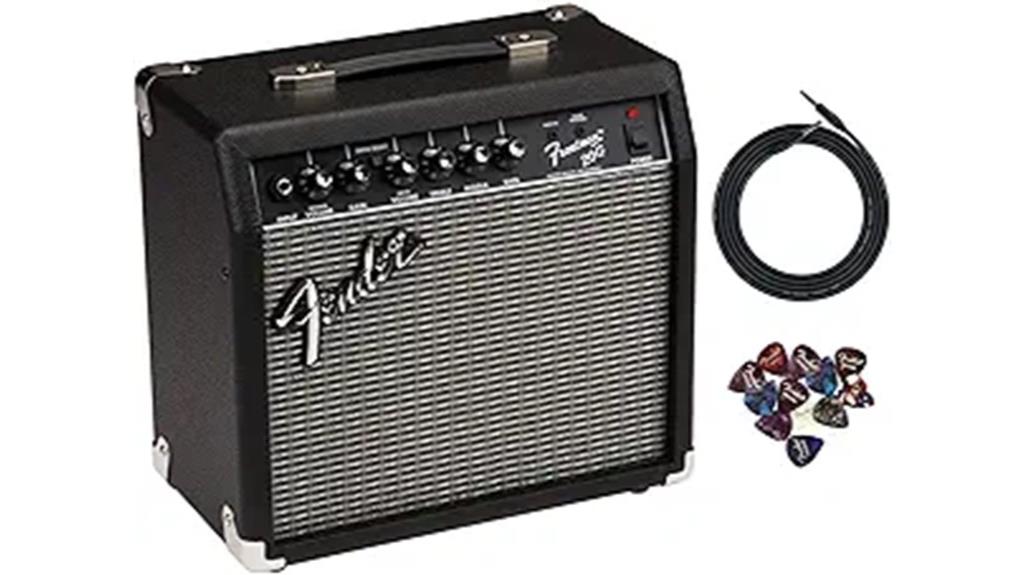
The Fender Frontman 20G strikes that sweet spot between affordability and functionality, making it a solid choice for musicians who need reliable amplification without breaking the bank. You’ll get 20 watts of power through an 8″ Fender Special Design speaker, which handles everything from clean jazz tones to crunchy rock sounds with surprising clarity. The built-in overdrive switch lets you toggle between pristine clean tones and gritty distortion instantly, while gain, volume, treble, and bass controls give you enough sonic flexibility for most situations. Practice features include auxiliary input and headphone jacks, so you can jam along with backing tracks or keep the neighbors happy during late-night sessions.
Best For: Beginner to intermediate guitarists looking for an affordable practice amp that can handle small performances and offers versatile sound options with convenient practice features.
Pros:
- 20-watt power output with 8″ Fender speaker provides clear, well-defined tones suitable for practice and small venues
- Built-in overdrive switch and comprehensive tone controls offer easy transitions between clean and distorted sounds
- Auxiliary input and headphone jacks enable silent practice and play-along capabilities with backing tracks
Cons:
- Limited power may not be sufficient for larger venues or band rehearsals with drums
- Single 8″ speaker configuration may lack the full frequency response of larger speaker setups
- Basic feature set without advanced effects or modeling capabilities found in more expensive amplifiers
Fender Mustang LT25 Guitar Combo Amplifier Bundle
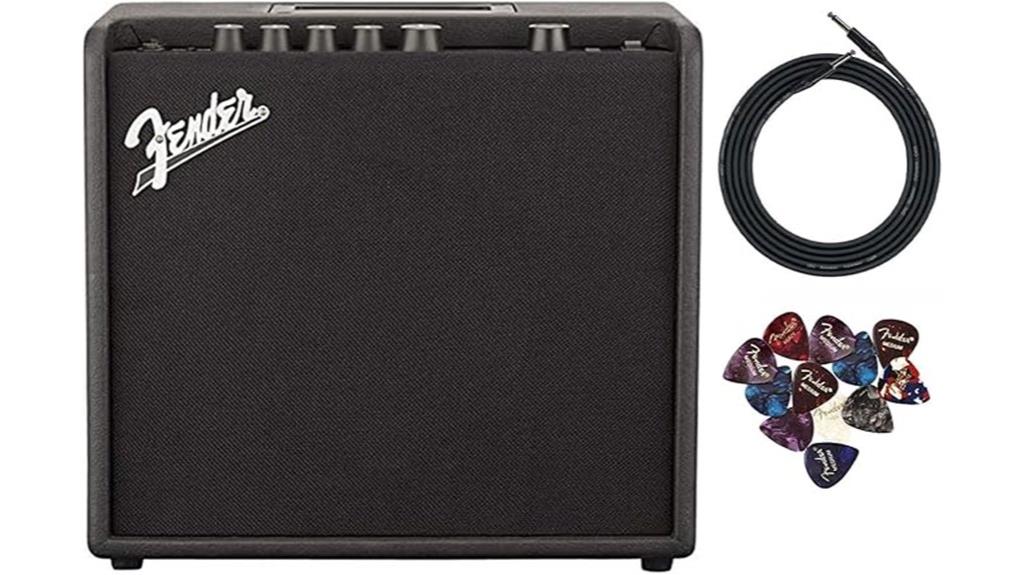
Weighing just 15 pounds with compact 8.25 x 14.5 x 12.75-inch dimensions, the Fender Mustang LT25 strikes an impressive balance between portability and performance that’ll serve gigging musicians who need reliable amplification without the back-breaking weight of traditional tube amps. This 25-watt combo delivers surprising versatility through its amp modeling options, including authentic Fender, Marshall, and Vox tones that cover everything from pristine cleans to aggressive overdrive. The 1.8″ color display makes managing presets straightforward during live settings, while the built-in tuner eliminates another piece of gear from your setup. USB connectivity handles direct recording when inspiration strikes.
Best For: Guitarists who need a lightweight, versatile practice amp with professional amp modeling capabilities for home use, small venues, and direct recording.
Pros:
- Authentic amp modeling of legendary brands (Fender, Marshall, Vox) with intuitive 1.8″ color display for easy preset management
- Lightweight 15-pound design with compact dimensions makes it highly portable for gigging musicians
- USB connectivity enables direct recording while built-in tuner eliminates need for additional equipment
Cons:
- Some users report concerns about the reliability of the on/off toggle switch over time
- At 25 watts, may lack sufficient power for larger venues or band practice with loud drummers
- Limited to single 8″ speaker configuration which may not provide the full-range sound of larger cabinet setups
FBA-10 Guitar Amp, 10W Mini Electric Guitar Amplifier
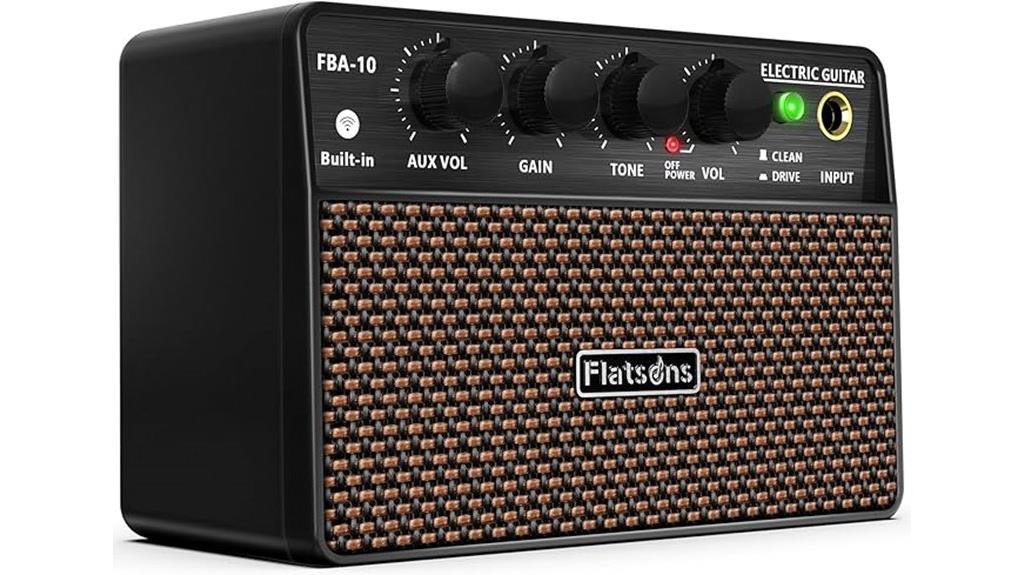
At just 1.46 pounds and measuring a mere 152x75x99mm, this FBA-10 Guitar Amp proves that exceptional performance doesn’t require hefty equipment, making it an ideal choice for musicians who need reliable amplification without the back strain. You’ll appreciate the dual tone modes—CLEAN for pristine sound and DRIVE for powerful tone—alongside GAIN and TONE controls that deliver surprising versatility from such compact dimensions. The 5.3 wireless connectivity lets you stream backing tracks directly from your phone, while the rechargeable battery provides six hours of continuous play, eliminating your dependence on power outlets during street performances or impromptu jam sessions.
Best For: Musicians who need a portable, lightweight amplifier for practice sessions, street performances, or casual jamming without access to power outlets.
Pros:
- Ultra-portable design at just 1.46 pounds with 6-hour battery life for complete mobility
- Dual tone modes (CLEAN/DRIVE) with GAIN and TONE controls offer versatile sound options
- 5.3 wireless connectivity allows seamless streaming of backing tracks from mobile devices
Cons:
- 10W power output may be insufficient for larger venues or band practice with drums
- Compact size limits speaker performance and overall volume capabilities
- Battery-dependent operation requires regular charging for extended use
Fender Frontman 10G Guitar Amp (10 Watts)
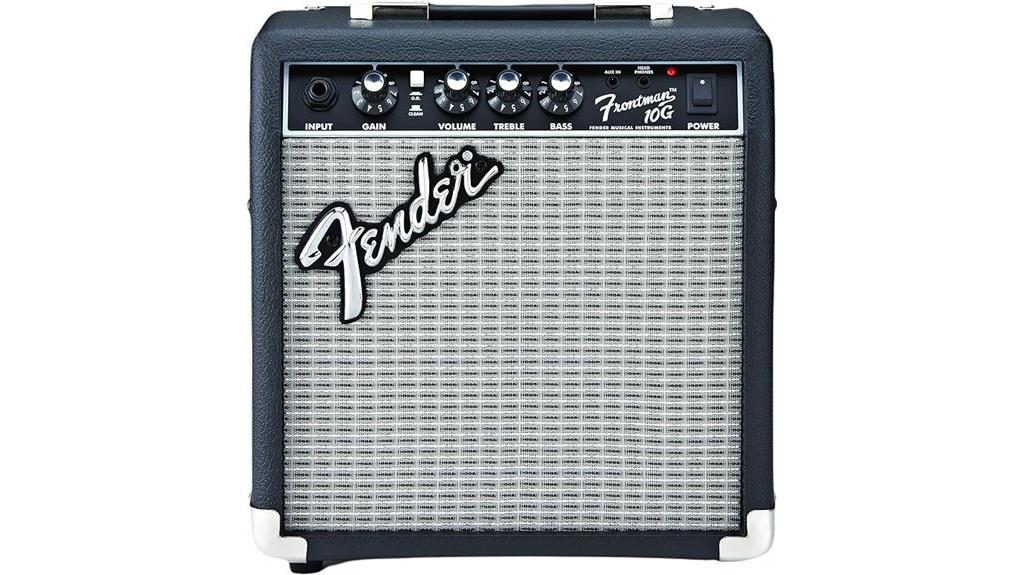
The Fender Frontman 10G stands out as an exceptional choice for guitarists who need a reliable, portable practice amp that won’t break their back during transport, weighing in at just 11.7 pounds while delivering surprisingly robust sound through its 6-inch Fender Special Design speaker. You’ll find its clean channel particularly impressive, offering three-band EQ controls alongside a separate overdrive channel that, while serviceable, works better as a foundation for your favorite distortion pedals. The closed-back design enhances bass response beyond what you’d expect from a 10-watt practice amp, and the auxiliary input lets you jam along with backing tracks while the headphone jack guarantees your neighbors won’t file noise complaints during late-night sessions.
Best For: Beginner to intermediate guitarists seeking a lightweight, reliable practice amp for home use that delivers clean tones and works well with external pedals.
Pros:
- Lightweight and portable at 11.7 pounds with surprisingly robust sound quality for its size
- Excellent clean channel with effective three-band EQ controls that maintain clarity at various volume levels
- Versatile connectivity options including auxiliary input for backing tracks and headphone jack for silent practice
Cons:
- Built-in overdrive channel is limited and works better as a foundation for external distortion pedals
- 10-watt power output may be insufficient for band practice or small venue performances
- Simple feature set lacks advanced options found in other amps in the same price range
Rockville G-AMP 20W Guitar Amplifier Combo with Bluetooth
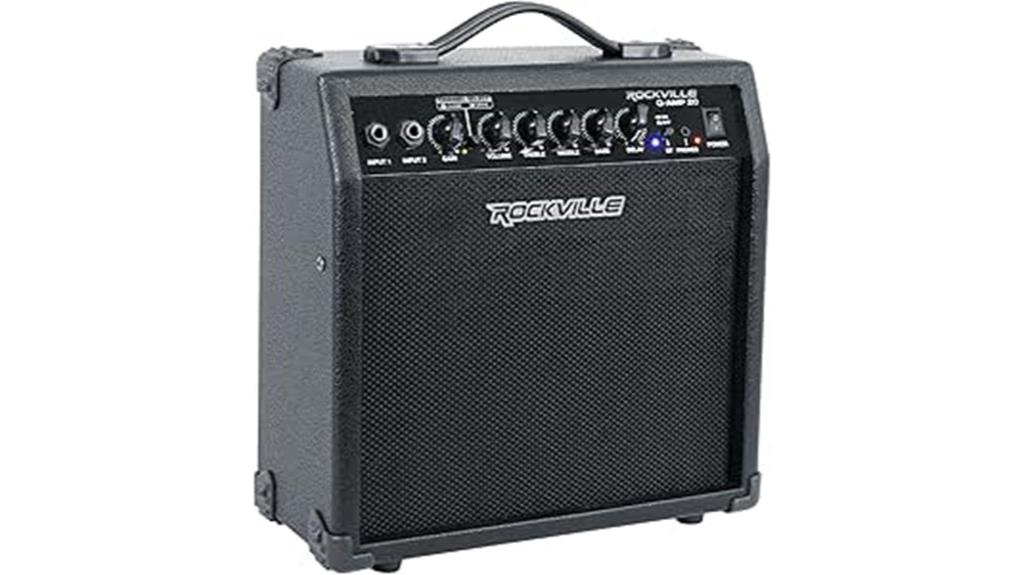
Budget-conscious musicians who need reliable amplification for both practice sessions and intimate venues will find the Rockville G-AMP 20W Guitar Amplifier Combo delivers impressive versatility in a surprisingly compact package. Weighing just 10.4 pounds with dimensions of 12.2 x 5.5 x 12.6 inches, you’ll appreciate how easily this amp travels between rehearsals and small gigs. The 20-watt output through a 6.5-inch speaker provides sufficient volume for coffee shop performances, while Bluetooth connectivity lets you stream backing tracks directly from your phone. You’ll get clean and overdrive channels, built-in delay effects, and dual inputs for jamming with friends or teaching students.
Best For: Budget-conscious guitarists who need a portable amplifier for practice sessions, small gigs, and jamming with the convenience of Bluetooth connectivity for backing tracks.
Pros:
- Compact and lightweight design (10.4 lbs) makes it highly portable for travel and small venues
- Bluetooth connectivity allows streaming of backing tracks directly from smartphones for play-along sessions
- Dual guitar inputs enable jamming with friends or teaching applications
Cons:
- Short AC power cord limits placement options and may require extension cord
- 20-watt output may be insufficient for larger venues or band rehearsals with drums
- Limited to basic effects with only built-in delay available
Factors to Consider When Choosing a Lightweight Guitar Amp for Gigging
When I’m helping musicians select the perfect lightweight amp for their gigs, I’ve learned that five critical factors consistently determine whether you’ll love or regret your purchase. The power output needs to match your venue size, the weight must align with your transportation method, and the built-in effects should cover your essential tones without requiring additional pedals. I’ll walk you through each consideration, from battery life expectations that won’t leave you stranded mid-set to connectivity options that integrate seamlessly with your existing gear setup.
Power Output Requirements
How much power do you actually need from your lightweight gigging amp, and what’s the sweet spot between portability and performance? I’ve found that 20 watts typically hits that perfect balance for most small venue gigs and practice sessions, providing enough headroom without weighing you down. For bedroom practice or coffee shop performances, 5-10 watts delivers surprisingly good sound quality while keeping things ultra-portable. Here’s the thing though – wattage directly correlates with volume projection, so if you’re playing larger spaces or with a drummer, you’ll want that 20-watt minimum to maintain clarity without distortion. I’ve learned the hard way that underpowered amps struggle at higher volumes, compromising your tone when you need it most during live performances.
Weight and Portability
Five pounds might not sound like much when you’re testing amps in a music store, but I’ve discovered that every ounce matters when you’re hauling gear up three flights of stairs to a cramped venue. I target amps between 5-15 pounds, which strikes the perfect balance between manageable weight and solid sound quality. Compact dimensions are equally essential since I need my amp to fit snugly in guitar cases or dedicated carry bags without creating awkward bulk. Modern lightweight amps often feature battery operation for outdoor gigs and Bluetooth connectivity for seamless backing track playback. While wooden cabinets typically deliver superior tone, they maintain reasonable weight, and the best designs enable quick setup adjustments between songs.
Built-in Effects Selection
Three essential effects categories form the backbone of any gigging amp’s built-in arsenal: clean channel versatility, distortion options, and time-based effects like reverb or delay. I’ve found that dedicated buttons or switches for quick tone changes streamline my performance shifts considerably, eliminating that awkward pause between songs while I fumble with settings.
The real advantage here is reducing your pedal dependency – fewer cables, less weight, and one less thing to malfunction mid-set. However, I’ve learned to prioritize quality over quantity when evaluating these built-in effects. A stellar reverb and solid overdrive beats ten mediocre options every time.
Consider your amp’s power output relationship with effects processing too, since stronger amplifiers typically maintain clarity and depth when pushing those digital processors harder.
Battery Life Duration
When you’re performing at outdoor venues, street corners, or any location where wall outlets remain elusive, battery life becomes your amp’s most critical specification – and I’ve learned this lesson the hard way during a few embarrassing mid-song shutdowns. Most quality portable amps deliver 5 to 6 hours of continuous play, though I’ve found that rechargeable models eliminate the constant expense and hassle of replacing disposables. Power efficiency markedly impacts longevity; amps that maintain consistent tone at lower wattages stretch battery life considerably further than their power-hungry counterparts. I always check user reviews for real-world performance data, since manufacturers’ claims rarely match actual gigging conditions. Additionally, following proper charging specifications, typically 5V 2A adapters, prevents premature battery degradation that’ll leave you scrambling for power sources.
Connectivity Options Available
Beyond keeping your amp powered throughout extended performances, modern connectivity features determine how versatile your lightweight rig becomes during actual gigs, and I’ve discovered that the right input and output options can transform a basic amplifier into a complete performance hub. Bluetooth functionality tops my priority list, enabling wireless streaming of backing tracks from smartphones during performances without tangled cables cluttering the stage. I always verify amps include auxiliary inputs, typically 1/8 inch jacks, for connecting external audio sources when wireless isn’t available. Headphone outputs prove invaluable for silent practice between sets, while USB interfaces facilitate quick recordings of spontaneous jam sessions. Dual-guitar inputs accommodate collaborative performances, though I’ve found this feature particularly useful when teaching students during downtime at venues.
Sound Quality Standards
Excellence in sound reproduction separates genuinely capable lightweight amps from toys masquerading as professional equipment, and I’ve learned that several critical factors determine whether an amp will deliver satisfactory performance during actual gigs. Power output between 5-25 watts provides adequate volume for most venues while maintaining tonal clarity, though I’ve found that speaker size matters more than I initially expected. Amps with 8-inch or larger speakers produce noticeably richer bass response and overall depth compared to smaller configurations. The frequency response range should ideally span 100Hz-20kHz to guarantee your sound translates well across different musical styles and playing dynamics. Built-in effects like distortion, reverb, and overdrive eliminate the need for additional pedals, streamlining your setup while maintaining the versatile sound profiles that customer reviews consistently praise.
Durability for Transport
Outstanding sound quality means nothing if your amp doesn’t survive the journey to your next gig, and I’ve learned this lesson through several unfortunate experiences with fragile equipment that looked great in the store but crumbled under real-world use. I now prioritize reinforced wooden cabinets or robust ABS plastic shells, which withstand constant loading, unloading, and inevitable bumps during transport. Closed-back designs protect internal components from impacts while improving overall sound isolation, something I appreciate when moving through crowded venues. Integrated handles or hanging capabilities make transport markedly easier, reducing strain on my back and minimizing drops. I’ve found that 5-20 watt amps offer the sweet spot between sufficient power and manageable weight, while customer reviews consistently reveal which models truly endure regular gigging demands.
Price Versus Features
When you’re balancing your gigging budget against feature needs, I’ve discovered that the $30-100 entry-level range offers surprisingly capable amps with clean and distortion channels that handle small venues admirably, though you’ll sacrifice advanced connectivity and effects processing that many modern performers expect. Moving into the $200-300 tier reveals multiple amp presets, USB recording capability, and extensive built-in effects that transform your performance versatility. I’ve learned that wattage directly impacts both price and venue suitability—while 5W mini amps keep costs down, they’ll struggle in larger spaces where 20W or 25W models excel. Before purchasing, I always check user ratings and five-star scoring systems, which reveal whether premium features justify the investment for your specific gigging requirements.
On a final note
I’ve tested countless amps over the years, and these lightweight options prove you don’t need to sacrifice tone for portability. Whether you’re hauling gear to coffee shops or outdoor venues, the right amp transforms your gigging experience from a back-breaking ordeal into something manageable. Consider your venue size, power requirements, and feature needs carefully—your spine will thank you, and your audience won’t know the difference.

